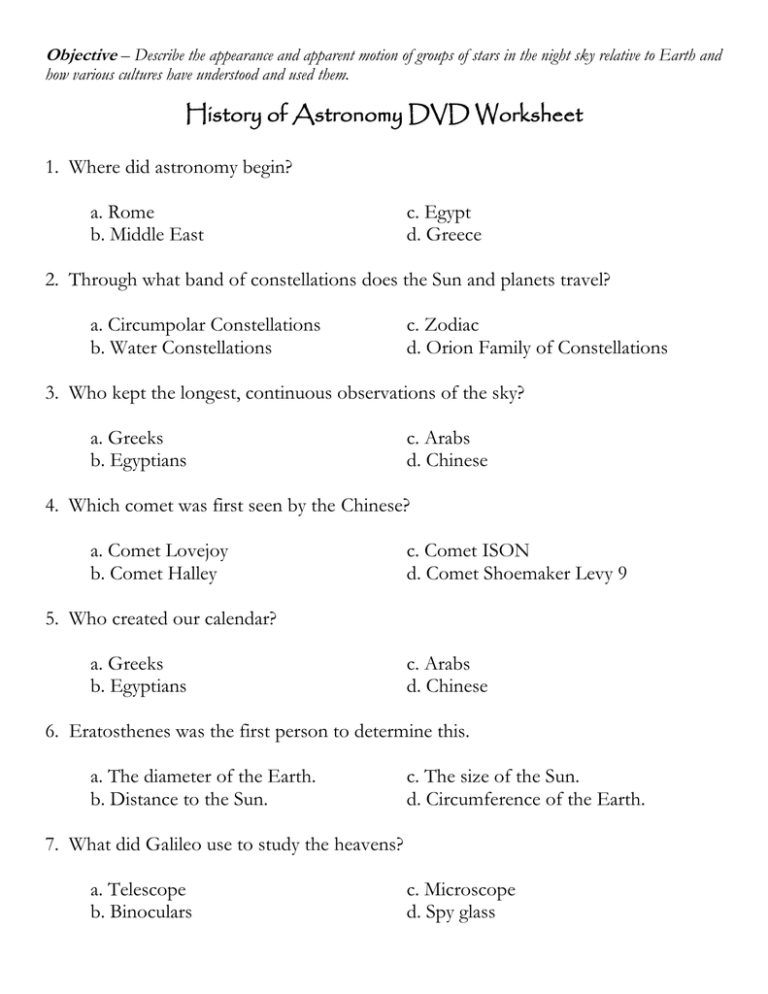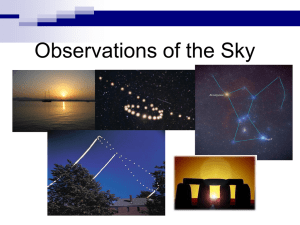Objective
advertisement

Objective – Describe the appearance and apparent motion of groups of stars in the night sky relative to Earth and how various cultures have understood and used them. History of Astronomy DVD Worksheet 1. Where did astronomy begin? a. Rome b. Middle East c. Egypt d. Greece 2. Through what band of constellations does the Sun and planets travel? a. Circumpolar Constellations b. Water Constellations c. Zodiac d. Orion Family of Constellations 3. Who kept the longest, continuous observations of the sky? a. Greeks b. Egyptians c. Arabs d. Chinese 4. Which comet was first seen by the Chinese? a. Comet Lovejoy b. Comet Halley c. Comet ISON d. Comet Shoemaker Levy 9 5. Who created our calendar? a. Greeks b. Egyptians c. Arabs d. Chinese 6. Eratosthenes was the first person to determine this. a. The diameter of the Earth. b. Distance to the Sun. c. The size of the Sun. d. Circumference of the Earth. 7. What did Galileo use to study the heavens? a. Telescope b. Binoculars c. Microscope d. Spy glass Objective – Describe the appearance and apparent motion of groups of stars in the night sky relative to Earth and how various cultures have understood and used them. 8. What type of telescope was developed by Newton? a. Refracting telescope b. Dobsonian telescope c. Reflecting telescope d. Schmidt-Cassegrain 9. Which planet was discovered by Herschel? a. Uranus b. Neptune c. Pluto d. Eris 10. In Chile, there are four telescopes that can work as one. a. True b. False Objective – Describe the appearance and apparent motion of groups of stars in the night sky relative to Earth and how various cultures have understood and used them. History of Astronomy DVD Fact Sheet True astronomy began in the Middle East. 4000 BC – Babylonians o Charted the rising and setting Sun. o Organized the sky into constellations. o Knew the Sun, Moon, and planets moved against the background stars. o Discovered Sun, Moon, and planets moved through a band in the sky. Called this the Zodiac. Tradition says there are twelve constellations. o There is a thirteenth – Ophiuchus the Serpent Bearer. The Chinese kept the longest, continuous observations of the sky. o They made calendars and star maps. o Solar Eclipses were first recorded in China. o Sunspots were observed with the naked eye. o The Chinese were the first to record a visit of Halley’s Comet. Egyptians created a calendar of 365 days in 3000 BC. o Watched for the first view of Sirius after the Sun rose. Marked the beginning of the flooding of the Nile. Greeks o Aristarchus of Samos The Moon shined with reflected light. The Earth revolved around the Sun. o Hipparchus Made the first star catalogue in the western world. o Eratosthenes Calculated the Earth’s circumference Mayans had a calendar based on the cycle of Venus. o Year lasted 584 days. Tycho Brahe o 1577 – Proved a comet was farther away from the Earth than the Moon. Galileo turned his telescope to the sky in 1609. o Discovered moon around Jupiter. o Saw craters on the Moon. o Saw the phases of Venus. 1781- Sir William Herschel discovered Uranus and mapped the Milky Way. 1949 – Edwin Hubble discovered the universe was expanding. We now send telescopes into space. Objective – Describe the appearance and apparent motion of groups of stars in the night sky relative to Earth and how various cultures have understood and used them. History of Astronomy 1. Where did astronomy begin? b. Middle East 2. Through what band of constellations does the Sun and planets travel? c. Zodiac 3. Who kept the longest, continuous observations of the sky? d. Chinese 4. Which comet was first seen by the Chinese? b. Comet Halley 5. Who created our calendar? b. Egyptians 6. Eratosthenes was the first person to determine this. d. Circumference of the Earth. 7. What did Galileo use to study the heavens? a. Telescope 8. What type of telescope was developed by Newton? c. Reflecting telescope 9. Which planet was discovered by Herschel? a. Uranus Objective – Describe the appearance and apparent motion of groups of stars in the night sky relative to Earth and how various cultures have understood and used them. 10. In Chile, there are four telescopes that can work as one. a. True (2 choices) Objective – Describe the appearance and apparent motion of groups of stars in the night sky relative to Earth and how various cultures have understood and used them. History of Astronomy 1. b 2. c 3. d 4. b 5. b 6. d 7. a 8. c 9. a 10. a (2 choices) Scoring Guide 10 – 4 9 – 3.5 8–3 7 – 2.5 6–2 5 – 1.5 4–1 1-3 – .5 0–0



